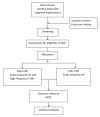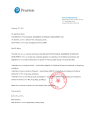Cognitive Improvement in Children With Cerebral Palsy Following Combined Scalp Acupuncture and High-Frequency Repetitive Transcranial Magnetic Stimulation (rTMS): A Prospective Observational Study
- PMID: 40641504
- PMCID: PMC12244392
- DOI: 10.7759/cureus.87672
Cognitive Improvement in Children With Cerebral Palsy Following Combined Scalp Acupuncture and High-Frequency Repetitive Transcranial Magnetic Stimulation (rTMS): A Prospective Observational Study
Abstract
Objective: To evaluate the clinical efficacy of combining scalp acupuncture and high-frequency repetitive transcranial magnetic stimulation (rTMS) for improving cognitive function in children with cerebral palsy (CP) and cognitive impairment. Methods: In this prospective observational study, 60 children with CP and cognitive impairment were recruited from January 2023 to June 2024 at a tertiary rehabilitation center. Participants were divided into two groups (n=30 each): the observation group received scalp acupuncture plus high-frequency rTMS (3 sessions/week), while the control group received scalp acupuncture alone (same frequency). Both groups underwent concurrent routine rehabilitation (150 minutes/session, three sessions/week) for 24 weeks. Cognitive function was assessed using WISC-IV before and after intervention. Statistical analyses included t-tests, chi-square tests, and non-parametric tests.
Results: Baseline characteristics (age, gender, and disease duration) showed no differences between the two groups (p>0.05). Pre-intervention, compared with the control group, total WISC scores were higher (64.74±4.00 vs. 60.07±4.54, p<0.001), and a greater proportion of children with mild cognitive impairment (25/30 vs. 14/30, p=0.037) were in the observation group. Post-intervention, compared with the control group, total WISC scores were higher (75.03±4.72 vs. 65.90±4.81, p<0.001), 65.90±4.81,p<0.001), mean change scores were increased (10.57±2.81 vs. 5.83±1.70, p<0.001), the Perceptual Reasoning Index was higher (82.26±7.62 vs. 74.16±10.31, p<0.001), and the Working Memory Index was higher (78.90±7.12 vs. 67.33±7.70, p<0.001) in the observation group.
Conclusion: The combination of scalp acupuncture and high-frequency rTMS significantly enhances cognitive function in children with CP and cognitive impairment compared to scalp acupuncture alone.
Keywords: cerebral palsy; cognitive improvement; high-frequency rtms; rehabilitation; scalp acupuncture.
Copyright © 2025, Shen et al.
Conflict of interest statement
Human subjects: Consent for treatment and open access publication was obtained or waived by all participants in this study. the Ethics Committee of Nuclear Industry 416 Hospital issued approval KJ2022021. The study was approved by the Ethics Committee of Nuclear Industry 416 Hospital. Animal subjects: All authors have confirmed that this study did not involve animal subjects or tissue. Conflicts of interest: In compliance with the ICMJE uniform disclosure form, all authors declare the following: Payment/services info: All authors have declared that no financial support was received from any organization for the submitted work. Financial relationships: All authors have declared that they have no financial relationships at present or within the previous three years with any organizations that might have an interest in the submitted work. Other relationships: All authors have declared that there are no other relationships or activities that could appear to have influenced the submitted work.
Figures
Similar articles
-
Repetitive transcranial magnetic stimulation influences cognitive-motor dual-task performance in children with cerebral palsy: a randomized controlled study.J Neuroeng Rehabil. 2025 Jul 19;22(1):169. doi: 10.1186/s12984-025-01702-z. J Neuroeng Rehabil. 2025. PMID: 40684180 Free PMC article. Clinical Trial.
-
Transcranial Direct Current Stimulation Combined With Repetitive Transcranial Magnetic Stimulation for Depression: A Randomized Clinical Trial.JAMA Netw Open. 2024 Nov 4;7(11):e2444306. doi: 10.1001/jamanetworkopen.2024.44306. JAMA Netw Open. 2024. PMID: 39535797 Free PMC article. Clinical Trial.
-
Non-invasive brain stimulation techniques for chronic pain.Cochrane Database Syst Rev. 2018 Mar 16;3(3):CD008208. doi: 10.1002/14651858.CD008208.pub4. Cochrane Database Syst Rev. 2018. Update in: Cochrane Database Syst Rev. 2018 Apr 13;4:CD008208. doi: 10.1002/14651858.CD008208.pub5. PMID: 29547226 Free PMC article. Updated.
-
Non-invasive brain stimulation techniques for chronic pain.Cochrane Database Syst Rev. 2018 Apr 13;4(4):CD008208. doi: 10.1002/14651858.CD008208.pub5. Cochrane Database Syst Rev. 2018. PMID: 29652088 Free PMC article.
-
Non-pharmacological interventions for improving language and communication in people with primary progressive aphasia.Cochrane Database Syst Rev. 2024 May 29;5(5):CD015067. doi: 10.1002/14651858.CD015067.pub2. Cochrane Database Syst Rev. 2024. PMID: 38808659 Free PMC article.
References
-
- Paediatric cerebral palsy prevalence and high-risk factors in Henan province, Central China. Yuan J, Wang J, Ma J, et al. J Rehabil Med. 2019;51:47–53. - PubMed
LinkOut - more resources
Full Text Sources
Miscellaneous


